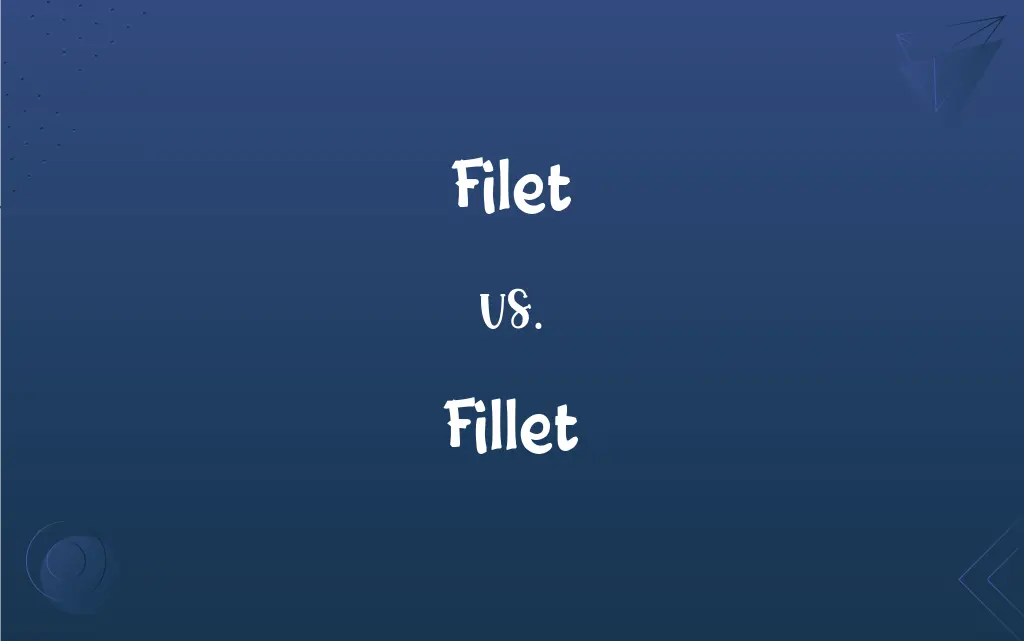Filet vs. Fillet: What's the Difference?
Edited by Aimie Carlson || By Harlon Moss || Updated on October 19, 2023
Filet and fillet both refer to a boneless cut of meat or fish, but "filet" is the preferred spelling in American English while "fillet" is standard in British English.

Key Differences
"Filet" and "fillet" are terms that can often be used interchangeably to denote a boneless piece of meat or fish. Especially when speaking about culinary dishes, both can be used to describe that tender cut of beef or that boneless portion of fish that many find delectable.
While "filet" and "fillet" might sound identical and often pertain to similar contexts, there's a regional distinction in their usage. In American English, "filet" is more commonly employed, especially when referencing French cuisine or specific cuts of meat, like filet mignon.
In contrast, "fillet" finds its roots in British English and is the more prevalent spelling in the UK and other English-speaking countries outside of the U.S. When you step into a British butcher or fishmonger, you'll likely request a "fillet" of beef or salmon rather than a "filet".
Furthermore, "fillet" in British English also has an additional usage beyond the culinary context. It can be used as a verb, denoting the action of cutting meat or fish into boneless pieces. On the other hand, "filet" typically remains as a noun in American English.
"Fillet" in engineering or carpentry denotes a rounded edge formed between two surfaces. This meaning is consistent across both American and British English, extending the term's versatility beyond the kitchen.
ADVERTISEMENT
Comparison Chart
Preferred Usage Region
Primarily American English
British English and other English-speaking countries
Part of Speech
Mainly a noun
Both noun and verb
Culinary Context
Refers to a boneless cut of meat or fish
Refers to a boneless cut of meat or fish and the action of making such cut
Other Usages
Specific to culinary contexts
Can be used in engineering or carpentry to describe a rounded edge
Example Dish
Filet mignon
Fish fillet
ADVERTISEMENT
Filet and Fillet Definitions
Filet
A kind of net or lace with a square mesh.
Her dress was adorned with delicate filet lace.
Fillet
A rounded molding used between the convex and concave parts in design.
The wooden frame had a decorative fillet.
Filet
A dish featuring a boneless piece of meat, especially beef.
The filet mignon was cooked to perfection.
Fillet
A boneless cut or slice of meat or fish.
I prefer the chicken breast fillet.
Filet
A narrow strip of ribbon or similar material, often headwear.
She wore a filet around her head, adding a touch of elegance.
Fillet
A band worn around the head, especially as a symbol of victory.
In ancient times, victors were often awarded a fillet as a symbol of their triumph.
Filet
A boneless piece of meat or fish.
I ordered a filet of salmon for dinner.
Fillet
The act of removing bones from meat or fish.
It takes skill to fillet a fish properly.
Filet
A term used in American English to describe a boneless cut.
The restaurant's special tonight is a beef filet.
Fillet
A narrow strip of any material.
The artist added a gold fillet around the painting's frame.
Filet
A net or lace with a simple pattern of squares.
Fillet
A narrow strip of ribbon or similar material, often worn as a headband.
Filet
Needlework done on a background of this net.
FAQs
What is the main difference between filet and fillet?
Both words refer to a strip or a boneless cut of meat or fish, but "filet" is the preferred spelling in American English while "fillet" is favored in British English.
Can both words be used interchangeably?
In many contexts, especially culinary, they can be. However, each form might be more recognizable to speakers from different English-speaking regions.
Which spelling is used in American culinary contexts?
"Filet" is commonly used, such as in "filet mignon."
Is there a context where "filet" and "fillet" have different meanings?
Yes, in crochet, "filet" refers to a type of design made by using open and filled squares. This meaning is not associated with "fillet."
How do I fillet a fish?
By using a sharp knife to remove bones and skin, resulting in boneless pieces of fish.
Are these terms used in vegetarian or vegan cuisine?
Yes, they can describe cuts or shapes of plant-based alternatives, like tofu or seitan "fillets."
How old are these terms?
Both have been in the English language since the late Middle Ages, with roots in Old French.
How are both words pronounced?
They are pronounced the same way: /fɪˈleɪ/.
Can "fillet" be used as a verb?
Yes, "fillet" can also mean to remove bones from meat or fish.
How do I decide which spelling to use?
Consider your audience. If they are primarily American, "filet" may be more recognizable. Otherwise, "fillet" is generally safe.
Are both words nouns?
Primarily, but "fillet" can also be used as a verb.
Does "filet mignon" have a specific meaning?
Yes, it refers to a specific cut of beef from the smaller end of the tenderloin.
Which industries primarily use these terms?
Culinary, woodworking, engineering, and anatomy, among others.
In engineering, what does "fillet" mean?
It refers to a rounded corner or edge on a design or object.
Is "filet" used outside of culinary contexts in American English?
Not commonly. "Fillet" tends to be the preferred term in non-culinary contexts.
Is "filet" used as a verb in American English?
Less commonly. "Fillet" is the more typical verb form in both American and British English.
In anatomy, what does "fillet" refer to?
It refers to a fleshy, boneless piece or slice.
Do other languages have similar terms?
Many languages have terms for boneless cuts of meat or fish, often derived from or similar to "filet" or "fillet."
Is the "t" in "filet" silent?
Generally, yes. Both "filet" and "fillet" typically have the "t" silent in pronunciation.
Where does the word "filet" come from?
It's derived from the Old French word "filet," meaning a thread or a strip.
About Author
Written by
Harlon MossHarlon is a seasoned quality moderator and accomplished content writer for Difference Wiki. An alumnus of the prestigious University of California, he earned his degree in Computer Science. Leveraging his academic background, Harlon brings a meticulous and informed perspective to his work, ensuring content accuracy and excellence.
Edited by
Aimie CarlsonAimie Carlson, holding a master's degree in English literature, is a fervent English language enthusiast. She lends her writing talents to Difference Wiki, a prominent website that specializes in comparisons, offering readers insightful analyses that both captivate and inform.































































